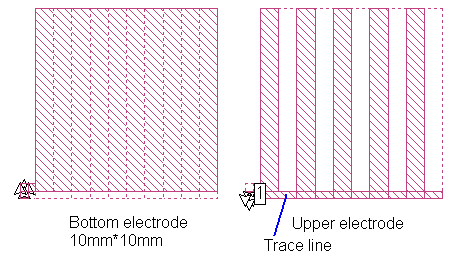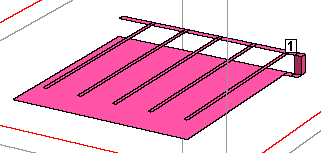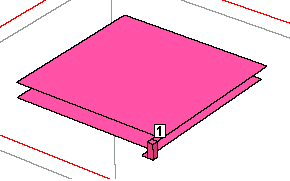- トップ
- 自己紹介,about
- 業務内容,business
- お知らせ,news
- 技術小論,articles
- 技術小論
- 記事
- スペアナ周波数特性点検システム
- アレイアンテナの指向性
- 並列共振回路
- 屋内半固定通信の弱電界領域への対応
- 試作時の細かい加工例
- デジタルマルチメーターの性能比較2
- DFTの定義が異なる理由
- デジタルマルチメーターの性能比較
- 無線分野の技師が扱ふ技術領域
- スミスチャートによる整合回路設計
- スミスチャートによる直並列変換
- アンダーサンプリングによる周波数移動と標本化周波数の低減
- オームの法則に従はない実験
- シート状導体の抵抗を電磁界シミュレーターで解析する
- 平行平板コンデンサを電磁界シミュレーターで解析する
- 平行平板コンデンサを電磁界シミュレーターで解析する2
- 平行平板コンデンサを電磁界シミュレーターで解析する3
- 平行平板コンデンサを電磁界シミュレーターで解析する4
- 導体と絶縁体の区分
- 電磁界シミュレーターによる静電容量式タッチセンサーの電極考察
- 分布定数回路理解のための電子工学
- リンク,links
- English,English
- SITEMAP
A planar capacitor analysis by EM simulator 3
3 Single comb-shape electrode capacitor
Next I tried a complicated case. I analyzed a capacitor of which electrode is comb-shape. Both of electrodes are not comb-shape. One electrode is comb-shape but the other one is still solid metal plane. It is like this.
Fig. 3.0
The bottom electrode has the same area to the previous analysis, 10mm*10mm. Here I changed the width of the comb teeth so as to reduce the area facing the bottom plane from 90% to 0%.
3.1 Expectation of the result
According to the analysis before, we can suppose that the capacitance would be in proportion to the area of the electrodes facing each other.Hereafter, let's see whether it is true or not.
To evaluate the effect of the width of comb teeth I changed the place of the trace line of the upper electrode. It was placed in the outside of the bottom electrode.

Fig. 3.1
3.2 Analysis result
The cycle of the comb teeth was 2.0mm. I reduced the width of the comb teeth from 2.0mm to 0mm by 0.2mm.Here I put the summary table.
| Overlapping ratio of electrodes | 40% | 30% | 20% | 10% | 0% |
| Comb teeth width and space | 0.8mm-1.2mm | 0.6mm-1.4mm | 0.4mm-1.6mm | 0.2mm-1.8mm | 0.0mm-2.0mm |
| Figure |  |
 |
|||
| Estimated capacitance | 4.70pF | 3.80pF | 2.85pF | 1.92pF | 0.239pF |
| Ratio of capacitance | 51% | 41% | 31% | 21% | 3% |

Fig. 3.2
The expectation was wrong. Seeing Fig. 3.2 the line of Ratio of capacitance (Blue line) is far from the expectation line (Dark green line). In 10% overlapping ratio the ratio of capacitance exceeds more than 10%.
Then I subtracted the capacitance in 0% case so as to know how much the trace line of the upper electrode affected. But the Magenta line is still far from the expected line. This difference is not a simple error.
I know that a capacitor which has this type of electrode is quite different from simple cases before.
3.3 Supposition of the reason for error
Probably, electric lines from the bottom electrode through gaps between comb tooth come back to the upper side of comb tooth. Those electric lines must increase the capacitance.In simple cases before, we can neglect electric lines which flow out from the edge of electrodes. But in this case we can not neglect them because of many electric lines through many gaps between comb tooth.

3.4 Local Conclusion
Capacitance of a single comb-shape electrode capacitor doesn't change in proportion to the overlapping ratio of electrodes. We can not neglect electric lines which pass gaps of comb tooth.The ratio of capacitance is more than the overlapping ratio of electrodes.
Issued on August 21, 2009

